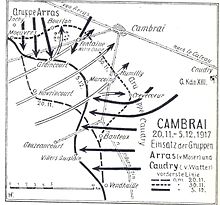2nd Army (German Empire)
The 2nd Army / Army High Command 2 (AOK 2) was a large unit and the associated command authority of the German Army during the First World War (1914-1918). It comprised several army or reserve corps as well as numerous special troops.
history
|
As on August 2, 1914 German Empire , the mobilization was made available from the eight were Army inspections made eight armies. From the III. Army inspection , the 2nd Army was established in Hanover , whose units gathered in the area south of Aachen . The Commander-in-Chief of Army High Command 2 was Colonel General Karl von Bülow . In August 1914 the army comprised the following corps units:
The 2nd Army marched in accordance with the Schlieffen Plan as part of the German army's right wing in Belgium , where the army high command 2 to improve coordination and the command of the 1st Army was transferred. However, this only resulted in friction with this command authority. Between August 22 and 24, 1914, both major formations had to endure the battles at Mons and Namur . At the end of August, the 2nd Army won the Battle of St. Quentin and was significantly involved in the Battle of the Marne from September 5th to 9th . After the Battle of the Aisne front froze in trench warfare . The headquarters of the Army High Command was in Saint-Quentin from October 10, 1914 to March 20, 1917 and then in Le Cateau until March 27, 1918 .
On July 1, 1916, the British troops began their long-prepared offensive against the 2nd Army (→ Battle of the Somme ). After some successes of the British units, the Supreme Army Command decided to restructure this section of the battle. On July 19, 1916, it divided the German troops in the area concerned. All forces north of the Somme were combined as a new 1st Army and remained subordinate to the previous Army High Command 2 . This was still under the command of General von Below, but has now been renamed Army High Command 1 . The German troops south of the Somme came as 2nd Army under the command of a new Army High Command under General von Gallwitz and his Chief of Staff Colonel Bronsart von Schellendorf.
At the beginning of 1917, the army took part in the retreat to the Siegfried position (→ Company Alberich ) and, after relocating AOK 1, held the front east of Arras - Queant (with the XIV. Reserve Corps ) - Bellicourt - St. Quentin (with the IX. Army Corps ). On November 20, 1917, the right wing of the 2nd Army was in the main field of attack of the British 3rd Army during the Cambrai tank battle . The XIV Reserve Corps lost some ground, but was able to hold on to the western apron of Cambrai. General von der Marwitz carried out a counterattack from November 30th: The Arras group attacked between Moeuvres and Bourlon, the Caudry group ( XIII Army Corps ) and Busigny ( XXIII Reserve Corps ) carried out diversionary attacks to the south near Marcoing via Banteux Vendhuille. The southern groups managed to advance eight kilometers over a width of around 16 kilometers. The Arras group, which started later, had less success, they managed to advance four kilometers over a width of ten kilometers by December 6, 1917.
During the German "Michael" offensive , the 2nd Army formed the middle of the three attack armies in the Cambrai area. On March 21, 1918, AOK 2 were subordinate to:
|
|
The breakthrough in the summer area reached the Amiens area by the beginning of April , where the front came to a standstill again. The Anglo-French counter-offensive in the Battle of Amiens on August 8, 1918 brought heavy losses to the 2nd Army and initiated fighting to retreat until the end of the war.
See also
Web links
- The highest command posts in the army. on www.deutsche-kriegsgeschichte.de (as of April 16, 2010)
- 2nd Army newspaper. LLB Detmold
literature
- Hermann Cron: History of the German Army in the World War 1914–1918. Siegismund, Berlin 1937 ( History of the Royal Prussian Army and the German Imperial Army 5).
Individual evidence
- ↑ a b Hermann Cron: History of the German Army in World Wars 1914–1918 , Berlin 1937, p. 395
- ^ A b Hermann Cron: History of the German Army in the World Wars 1914–1918. Berlin 1937, p. 76
- ^ Hermann Stegemann: History of the war. Volume 1. Stuttgart / Berlin 1917, p. 103.
- ^ Hermann Stegemann: History of the War , Vol. 4, Stuttgart / Berlin 1921, p. 129.


